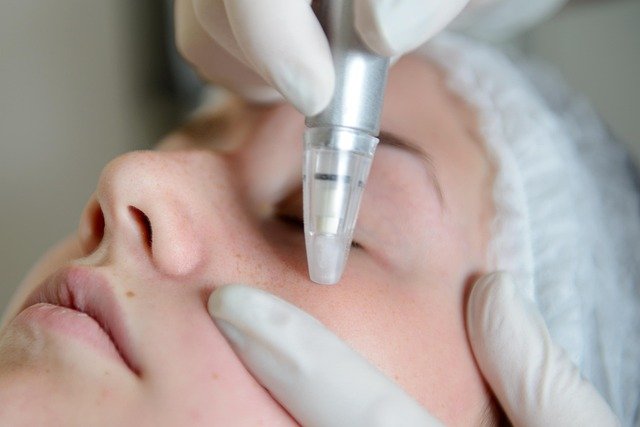Microneedling: Revolutionizing Skin Rejuvenation
Microneedling, a minimally invasive cosmetic procedure, has emerged as a game-changer in the field of dermatology and skincare. This innovative technique involves creating controlled micro-injuries to the skin using tiny, sterile needles. The process stimulates the body's natural healing response, triggering collagen and elastin production. As a result, microneedling has gained popularity for its ability to address a wide range of skin concerns, from fine lines and wrinkles to acne scars and hyperpigmentation. Its versatility and effectiveness have made it a go-to treatment for those seeking to improve their skin's texture, tone, and overall appearance without resorting to more invasive procedures.

How Microneedling Works
At its core, microneedling capitalizes on the skin’s innate ability to heal itself. When the tiny needles create microscopic punctures in the skin, they trigger a cascade of biological responses. The body perceives these micro-injuries as damage and initiates repair mechanisms. This process stimulates fibroblasts, the cells responsible for producing collagen and elastin. As a result, the skin experiences increased collagen synthesis, which helps to plump and firm the skin, reducing the appearance of fine lines and wrinkles. Additionally, the micro-channels created by the needles allow for better penetration of topical skincare products, enhancing their efficacy.
The Evolution of Microneedling Devices
Since the introduction of the Dermaroller, microneedling technology has advanced significantly. Modern devices range from at-home rollers to professional-grade automated pens. Professional treatments often utilize devices like the Dermapen or SkinPen, which offer adjustable needle depths and more precise control. These advancements have led to the development of techniques like RF microneedling, which combines traditional microneedling with radiofrequency energy for enhanced results. The evolution of these devices has not only improved treatment outcomes but also expanded the range of skin concerns that can be effectively addressed.
Addressing Various Skin Concerns
One of the most remarkable aspects of microneedling is its versatility in treating a wide array of skin issues. For those battling acne scars, microneedling can help break down scar tissue and stimulate new collagen growth, leading to smoother skin texture. In cases of hyperpigmentation, the treatment can help even out skin tone by promoting cell turnover and reducing the appearance of dark spots. Microneedling has also shown promising results in improving the appearance of stretch marks and surgical scars. Furthermore, its collagen-boosting properties make it an effective anti-aging treatment, helping to reduce fine lines and wrinkles while improving overall skin firmness and elasticity.
The Role of Microneedling in Combination Therapies
While effective on its own, microneedling’s potential is further amplified when combined with other treatments. Many practitioners now offer combination therapies that leverage the benefits of microneedling alongside other modalities. For instance, combining microneedling with platelet-rich plasma (PRP) therapy, often referred to as the “vampire facial,” has gained popularity for its potential to enhance skin rejuvenation. The micro-channels created by needling allow for better absorption of PRP, which is rich in growth factors. Similarly, pairing microneedling with specific serums or active ingredients can target particular skin concerns more effectively, offering customized treatment options for patients.
Safety Considerations and Potential Side Effects
Despite its minimally invasive nature, microneedling is not without risks. When performed by a trained professional using sterile equipment, the procedure is generally safe. However, improper technique or inadequate sterilization can lead to complications such as infection, scarring, or hyperpigmentation. Common side effects include temporary redness, swelling, and mild irritation, which typically subside within a few days. It’s crucial for individuals considering microneedling to consult with a qualified practitioner and disclose any existing skin conditions or medications that might affect their suitability for the treatment.
The Rise of At-Home Microneedling
The popularity of microneedling has led to the development of at-home devices, making the treatment more accessible to consumers. These devices typically feature shorter needles and are designed for gentler, more frequent use. While they can provide some benefits, it’s important to note that at-home treatments are not as potent as professional procedures. Users should be cautious and follow instructions carefully to avoid damaging their skin. Moreover, certain skin conditions may be exacerbated by improper use of at-home devices, underscoring the importance of professional guidance in skincare routines.
Future Developments and Research
As microneedling continues to gain traction in the skincare industry, ongoing research is exploring new applications and refining existing techniques. Current studies are investigating the potential of microneedling in treating hair loss, delivering medications transdermally, and even improving the appearance of cellulite. Additionally, advancements in needle technology and device design are focusing on enhancing treatment precision and patient comfort. The integration of artificial intelligence and machine learning in microneedling devices is another area of development, potentially allowing for more personalized and effective treatments in the future.
In conclusion, microneedling has established itself as a versatile and effective tool in the realm of skin rejuvenation. Its ability to harness the body’s natural healing processes to improve skin quality has made it a popular choice among both practitioners and patients. As technology advances and research continues, microneedling is likely to play an increasingly significant role in both medical and cosmetic dermatology. However, as with any medical procedure, it’s crucial for individuals to approach microneedling with informed expectations and under the guidance of qualified professionals to ensure safe and optimal results.





